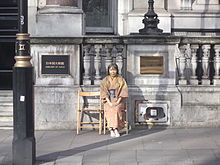利用者:Hikari tm/sandbox
嶋田美子は映像作家だけではなくパフォーマンスアーティストとして[1] 、「女性と戦争」をテーマに作品を手がけている。[2]
作家紹介
[編集]嶋田は1960年代に米軍の空軍拠点として、西日本の立川で生まれ育ち、米軍戦後の緊張を間近にさらされた。[3][4] 1982年にスクリップ大学で人文科学の学士を得て卒業、その後2015年にロンドンのキングストン大学で博士号を取得する。[5][6]

嶋田は文化的記憶と第二次世界大戦における女性の役割が侵略者と犠牲者の療法であることをテーマの中で探求している。Among the themes she explores are cultural memory and the role of women in World War 2 as both aggressors and victims. Her 1992 etching Shooting Lesson, for example, juxtaposes portraits of four Korean comfort women with a photograph of the wives of Japanese military police stationed in Korea receiving shooting lessons for self-protection against the local population.[7] In her 1993 installation Tied to Apron Strings, she uses white aprons as both a symbol of domesticity and motherhood and as a reminder of the uniform of the Dai Nippon Fujinkai, a women's patriotic organization of World War 2 Japan.[8] Shimada's interactive installation Bones in Tansu: Family Secrets, in which she solicited the war memories of museum visitors and incorporated them into the exhibit, first appeared in Tokyo in 2004 and then in seven other locations around the world.[9] She performed Becoming a Statue of a Japanese Comfort Woman outside the Japanese embassy in London in 2012.[10]
Shimada's works are held by the New York Public Library, Tokyo Metropolitan Museum of Photography, Keio University Art Center, Kyoto Seika University, and City University of New York.[11] She has had solo exhibitions in Japan, Hong Kong, the Philippines, Canada, and the United States, and her work was included in the 2002 Gwangju Biennale in South Korea.[12]Shimada curated the Bigakkō portion of the Anti-Academy exhibit at the John Hansard Gallery in 2013-14.[13]
Shimada has been included in the Asian American Arts Centre's digital archive.[14][15]
Further reading
[編集]- Borggreen, Gundhild (2013). "Archives of Secrecy: Yoshiko Shimada's Art Project Bones in Tansu--Family Secrets." In Borggreen, Gundhild; Gade, Rune. Performing Archives/Archives of Performance. UK, Ireland, and Scandinavia: Museum Tusculanum Press. pp. 403–417. ISBN 9788763537506.
- Osborne, Catherine, Yoshiko Shimada, and Meg Taylor. Divide and Rule: Yoshiko Shimada. Toronto: A Space Gallery, 1997. ISBN 978-0969506874
- Shimada, Yoshiko. Art Activism 1992-98. Tokyo: OTA Fine Arts, 1998.
- Tan, Eliza. "Revisiting Art, Feminism and Memory in Singapore and Japan since the 1990s: Amanda Heng and Yoshiko Shimada," n.paradoxa: international feminist art journal 39 (January 2017): 5-17.
- Yu-Rivera, Helen. "Demystifying the Japanese Household: Bones in the Tansu," Ctrl+P Journal of Contemporary Art 4 (December 2006): 2-4. [1]
References
[編集]- ^ “Archived copy”. December 3, 2013時点のオリジナルよりアーカイブ。November 23, 2013閲覧。
- ^ “Feminist Charts No Woman's Land between Peaceniks and the SDF”. 2015年3月7日閲覧。
- ^ “Catalog”. 2015年3月7日閲覧。
- ^ “Artist Biography”. 2015年3月7日閲覧。
- ^ “Artist Resume”. 2015年3月7日閲覧。
- ^ “Visual and Material Culture Research Centre”. 2017年8月1日閲覧。
- ^ “Leza Lowitz, "Past Imperfect," Tokyo Journal (August 1992): 41-42”. 2015年3月7日閲覧。
- ^ “Artist Statement”. 2015年3月7日閲覧。
- ^ “Rebecca Jennison and Laura Hein, "Against Forgetting: Three Generations of Artists in Japan in Dialogue about the Legacies of World War II," The Asia-Pacific Journal Vol 9, Issue 30 No 1 (July 25, 2011).”. 2015年4月12日閲覧。
- ^ “Fight For Justice”. 2015年4月13日閲覧。
- ^ “Artist Resume”. 2015年3月7日閲覧。
- ^ “Artist Resume”. 2015年3月7日閲覧。
- ^ “Anti-Academy”. 2017年8月1日閲覧。
- ^ artasiamerica digital archive
- ^ “Shimada, Yoshiko”. 2013年6月24日閲覧。

